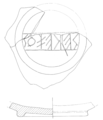CO·57
| Inscription | |
|---|---|
| Reading in transliteration: | sekezos |
| Reading in original script: | |
|
| |
| Object: | CO·57 Prestino (bowl) |
| Position: | foot, outside |
| Frame: | |
| Direction of writing: | sinistroverse |
| Script: | North Italic script (Lepontic alphabet) |
| Number of letters: | 7 |
| Number of words: | 1 |
| Number of lines: | 1 |
| Workmanship: | scratched into leather-hard clay |
| Condition: | complete |
|
| |
| Archaeological culture: | Golasecca III A 2 [from object] |
| Date of inscription: | second half of 5th c. BC [from object] |
|
| |
| Type: | mark of manufacturer |
| Language: | Celtic |
| Meaning: | 'Sekezos' |
|
| |
| Alternative sigla: | Motta 2000: 13 1 Morandi 2004: 189 |
|
| |
| Sources: | Morandi 2004: 644 no. 189 |
Images
Commentary
First published in Motta 2000: 207 f., no. 13.1.
Images in Motta 2000: 207, fig. 10 (drawing), Morandi 2004: 647, fig. 23.189 (drawing), Stifter 2020: 40, fig. 27 (photo).
Inscribed before the firing across the foot of the bowl, which, in combination with the repeated attestation at the same find spot (see CO·58, CO·59, CO·60), makes a manufacturer's signature likely (thus Morandi; cf. the plioiso-group), though the execution is not identical in the four inscriptions (forms of sigma and kappa, direction of the bars of zeta, frame). The present one is very neat and framed by lines above and below.
The sequence sekezos is an o-stem personal name in the nominative; the problem of the inscription lies in the interpetation of the spelling. Kappa probably stands for /g/ (base sego-); zeta could in principle stand for /t/ (suffix -et-) or /d/ (suffix -ed-), or an affricated/palatalised allophone of either sound before a i̯-suffix. Zeta for /t/ can be excluded, as this has neither parallels nor motivation. Zeta for /d/ presumes an influence of the Venetic Este alphabet, where zeta has this exact function. Whether one would expect such immediate Venetic influence at Lepontic Como in the 5th century depends on one's opinions on the derivation of the Lepontic alphabet (directly from Etruscan or with Venetic mediacy), and a case has been made for the later use of san for /d/ to be modelled on Venetic zeta for /d/, but in the Cisalpine Celtic corpus zeta for /d/ is only otherwise attested in the Oderzo inscription TV·1 (pazros), which appears to use a Venetic or mixed alphabet. Also, if the orthography of the inscription made use of the Este alphabet's ability to denote mediae, we would expect /g/ to be spelled with chi. There is no reason to assume that the velar is strengthened and kappa thus appropriate also with Venetic spelling (cf. a similar problem in MN·1 sekenei). Zeta, which in the Lepontic alphabet should be expected to denote a marked dental or sibilant, cluster or affricate (cf. CO·48 uvamokozis, and see Z), is thus more likely to represent an affricated/palatalised /t/ in seg-et-i̯-os [segetsos] or [segecjos] vel sim. or seg-ed-i̯-os [segedzos] or [segeɟjos] vel sim. This presupposes that the suffix in this formation is shortened to /i̯/. Cf. MI·10.1 for a possible spelling of affricated/palatalised /t/ with san. /t/ in the suffix -et-, however, is more plausible linguistically (see the word page; cf. Stifter 2020: 39 f.). The discussion also involves NM·6.1/NM·6.2 seχeθu, although the names must not necessarily be formed with the same suffix (seχeθu in any case evidently lacks a i̯-suffix).

